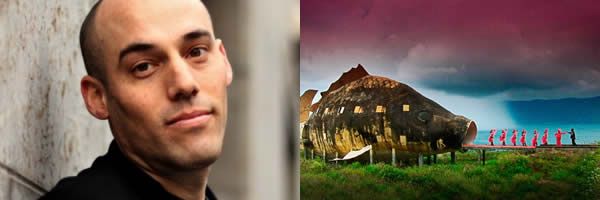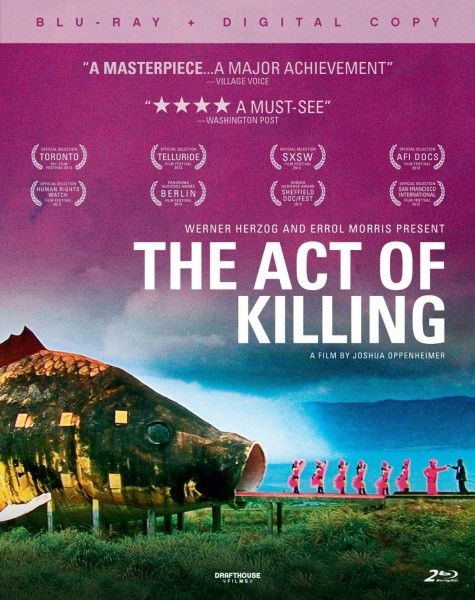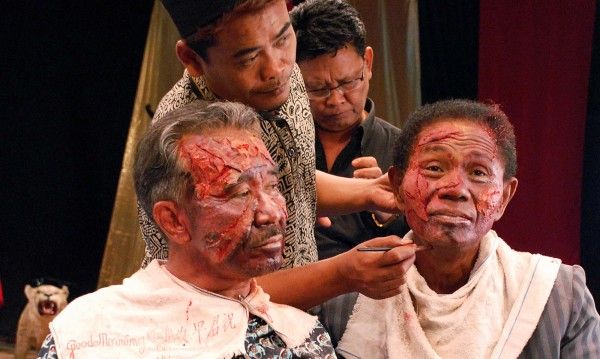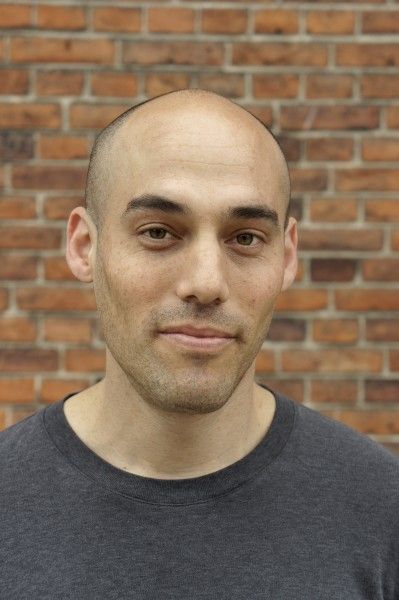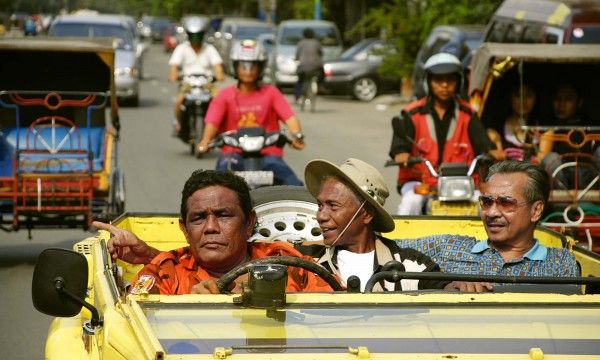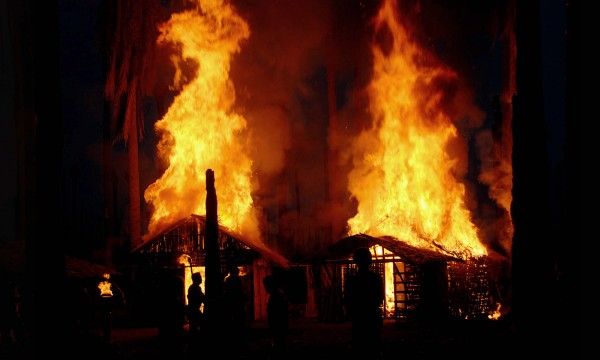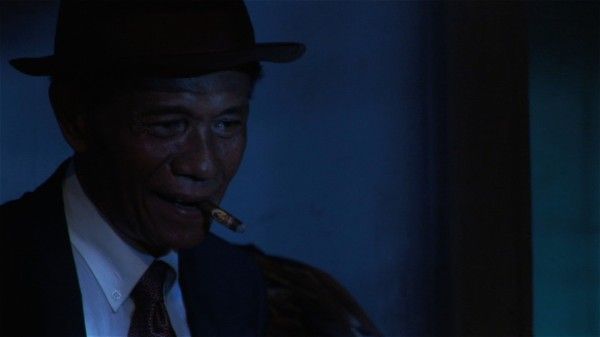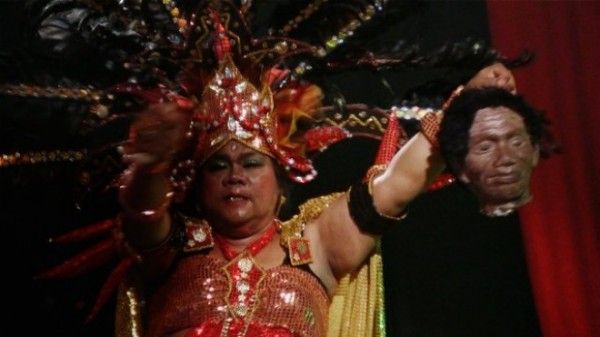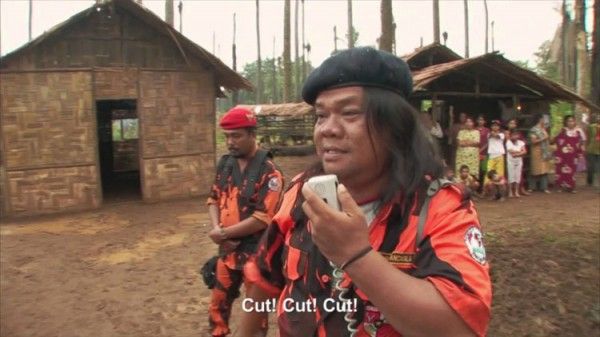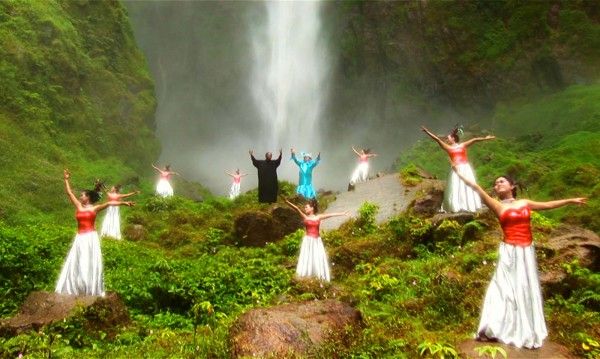Joshua Oppenheimer's The Act of Killing was my favorite film of 2013. While other documentaries have explored genocide, Oppenheimer's unique approach yielded jaw-dropping results. The film looks at the killers who slaughtered thousands of "communists" (i.e. anyone declared undesirable by the government) from 1965-1966, and Oppenheimer asked the murderers to create filmed reenactments of the killings. Their methods and scenes are revelatory, horrifying, and surreal. Oppenheimer's documentary is unlike anything I've ever seen before.
Last week, I had the chance to speak with Oppenheimer, and I feel like even though we had an extended interview (we spoke for over half an hour), we only scratched the surface. During out conversation, he talked about why the murderers equate the word "gangster" with "free man", the filmmaking process, the more surreal scenes of the picture, especially the "talk show" scene, how the film has impacted Indonesia, the director's cut, and much more. Hit the jump to read the interview. The Act of Killing is now available on Blu-ray, DVD, and VOD, and I highly encourage you to watch it.
Thank you for taking the time to talk with me. I’m glad we could do this interview. This is my favorite film of the year.
JOSHUA OPPENHEIMER: Oh, that’s so nice of you to say.
I caught it back at South by Southwest, and it’s stuck with me ever since. I haven’t really been able to shake it -- and saw it again a couple weeks ago, and again it makes my brain do a popping sound when I watch it.
OPPENHEIMER: Oh no! That doesn’t sound good.
No, I mean in a good way. It really sends me for a loop. So just to dive right into it, one of the things I wanted to talk to you about is in the film they repeatedly say that “gangster” comes from the word “freeman,” and in English it doesn’t.
OPPENHEIMER: No.
So I was curious about the etymology of the English word versus the Indonesian etymology of the word “gangster.”
OPPENHEIMER: I’m not exactly sure what the English etymology is.
It really just comes from “gang,” which means “grouping.” So that’s sort of the English etymology.
OPPENHEIMER: In Indonesian, the word isn’t translating as “gangster.” It’s "preman", which comes from the Dutch “préman”, which of course the thing that’s “freeman” in English. The Dutch is part of the way of legitimizing the colonial role, which was inherently exploitative and lawless, in a way. It was a way to get the near lawful men to work for a lawless regime. They used gangsters and they used thugs to do their dirty work, and they recruited people without the same social and family ties that other people have -- and they were known as “préman.” After the Dutch left Indonesia, after the Indonesians got loose in 1945, the freemen were not as widely used, but then they went through a real Renaissance where military dictatorship took over. And they were recruited from the children of the préman who had served the Dutch. So they were anti-independence, they were right-wing. They were counter-revolutionary in a sort of way, and they were used to do the government’s dirty work just as the Dutch had used them, and that went on for a long time. In a sense, the word “préman” has been used as an accident in etymology in a way -- well, it’s not really an accident -- it’s been used to legitimate, to euthanize the existence of a lawless, parallel power structure. It means doing the dirty work for the government, and it means anybody who’s street-tough, who’s unemployed, hanging around on streets, who are very, very oft in an organized crime syndicate, and one word that I thought sort of captured all of that whole sense in English is gangster. “Thug” would sound too low level. “Mafia boss” would sound too high level. So often it’s translated as gangster.
Because Anwar Congo and his cohorts talk about going to see gangster movies when they were young. Was the term “préman” used in those films, or how does that translation work?
OPPENHEIMER: That’s part of our decision to use the translation “gangster.” They were outlaws. Anwar and Adi [Zulkadry] were trying to kill people before 1965. Before they were involved in any political killings, they were hired as hit men, and then they found a kind of glorified image of themselves in the anti-heroes of American gangster movies. So the translation of gangster is particularly resonant for Anwar, who uses the word gangster when talking about the heroes of Hollywood genre, and the heroes and anti-heroes of that genre.
Sitting through the credits, so much of the crew is listed anonymously, and I was curious how you got them to sign on to do the movie, and what were their reasons?
OPPENHEIMER: Well, I think making this movie is a collaboration with a community of survivors of the genocide and shortly after we started filming, the army found out what we were doing. The army stationed at every village in Indonesia. They would no longer let the survivors participate in the film.
Was this the nation’s army or the paramilitary Pancasila Youth?
OPPENHEIMER: The nation’s army. The paramilitary are kind of an adjunct force of the nation. The army wouldn’t let the survivors participate in the film, so the survivors themselves said, “Look, living all around us are the people who did this to us, and they may tell you how our loved ones were killed.” At the time of filming, I didn’t know if it was safe to film the perpetrators at all -- that was in 2003 -- so I went and filmed these neighbors of mine, and I was astounded. They immediately responded with these boastful, detailed accounts of mass killing, that they would tell with a smile on their face -- often in front of their children, their wives, even their grandchildren. Now, in this contract between survivors who were forced into silence and perpetrators who were boasting, I had this awful feeling I’d wandered into Germany forty years after the Holocaust only to find the Nazis still in power. And I knew I would give this situation as many years of my life it would take, but when I showed that footage back to the survivors who wanted to see it and the Indonesian Human Rights Committee -- the footage of the perpetrators of the village -- everybody said, “You’re on to something terribly important. Keep filming the perpetrators, because any Indonesian who sees this will be forced to acknowledge that we’re all afraid,” and that’s precisely why. We’re forced to acknowledge the raw heart of this regime. So I then, feeling backed by the survivors and the Human Right Committee, spent two years filming every perpetrator I could find until I met Anwar, and that was not a casting process. I lingered on Anwar because there was something about his pain was closest to the first -- and doing that two year process, all sorts of people, documentary filmmakers, professors of literature, activists, and human rights advocates were offering to help, we’re volunteering to help. So that long credit scroll of sixty anonymous names, it’s people who dedicated eight years of their lives to making the film, risking their safety. Knowing that they were risking their safety, knowing that they wouldn’t be able to take credit for their work until there’s a major political change in Indonesia. All of them were somehow committed to this specific notion that the film could help bring about this change.
There’s just so many spine-chilling, mind-blowing scenes, and the one that’s really stayed with me is the talk show, and I was wondering if you could explain how the role of that program works in Indonesian society.
OPPENHEIMER: That talk show, it’s interesting, it’s just as shocking and horrifying for Indonesians as it is for American or anybody else, and it’s also for Indonesians to see finally -- they’re the institutions that just hate television, public television, and it’s always idiotically supporting the government. They’re the institution that’s functioned as a mask for this regime. Finally, irreversibly unmasking the regime. And so Indonesians see that and laugh and are horrified at the same time. And the reason it’s shocking for Indonesians is with the genesis of the show. Indonesian State Television for The Act of Killing will probably not talk about the genocide as a genocide at all. They wouldn’t talk about the murders, they wouldn’t talk about the killing. They would talk about a heroic chapter in Indonesian history where the Communists are exterminated. They use the word “exterminate.” But they don’t go into what that really means. They pass a kind of patriotic, heroic language to what’s ultimately mass murder. Now with some ordinary perpetrators who had to live with what they’ve done all their lives, they've had to attach those words that allow them to feel good about what they’ve done. These individual perpetrators are haunted by horrible memories of cutting off people’s heads, strangling people, and they have to live with them. So they attach the same heroic, patriotic rhetoric to these grisly details about what they’ve done -- trying to make it okay, trying to legitimate it. Above it all, I think to themselves. So that combination of feelings, it inevitably underlines the illusion that these things were heroic. To have someone talk about strangling hundred of people who were bound and not resisting and saying that it’s patriotic of course shows that that means what’s patriotic is a lie. And the perpetrators in Medan and North Sumatra, some of them were very powerful and including their publisher, the papers there, the governor of the province, were talking boastfully about what they did and what their friends did, to my cameras, and that in itself became a news story in North Sumatra. The state television studio in North Sumatra, which is one of the bigger regional state television studios, got all of these powerful local officials -- politicians, local heroes like Anwar -- talking about what they do, and I think they started saying to themselves, “This is a big story. These people are making a fairly large film about this, with Josh, and they believe we’re too conservative in the way we’ve been talking about this over the past decade. And if they’re willing to talk about it, then we should talk about it too. And we invited them on the show and invited them to talk about it.” And created something therefore that’s totally out of step with how television had represented genocide up to that point. So you can see that The Act of Killing has led the Indonesian media, since it’s release to fundamentally reappraise what they did, what happened in Indonesia, as far as reporting on the genocide honestly as a genocide, and you could. And you could sort of say that process ironically began with that talk show, so that’s why it’s as jaw dropping for Indonesians as for everyone.
Now, of course, on the talk show, it’s a very positive appraisal. They’re talking about it openly, but not in an, “Oh my God, this was horrible.” They just feel now looser with the language. Is that how the rest of the media is going, or are they going, “This is horrible. Why are you smiling?”
OPPENHEIMER: No, no, no. The rest of the media now is talking about the genocide as a genocide, and saying it’s awful. Before we released the film in Indonesia, we had screenings at the National Human Rights Commission in Jakarta for Indonesia’s leading filmmakers, celebrities, historians, intellectuals, artists, and above all survivors, human rights groups -- but above all, media people; publishers and editors for Indonesia’s leading new outlets. The editors of the biggest news outlets of Indonesia magazines before The Act of Killing and after The Act of Killing. “I’ve been censoring stories about the genocide ever since I’ve been in this job. Your film showed me that I do not want to do that anymore because I do not want to grow old as a perpetrator. That’s what your film showed me. And I’m going to break my silence about the killings. We’re going to publish a double edition of our magazine showing that The Act of Killing is a repeatable experiment, that it could have happened anywhere in Indonesia. There’s ten thousand men like Anwar out there, and it’s a problem with corruption, thievery, impunity, fear, and it highlights our systemic problems.” So she sent sixty journalists around the country, dropping whatever else they were reporting on for two weeks, to look for men like Anwar who were both. Essentially doing what I did in the first two years before I met Anwar -- and to their horror, but I don’t think their surprise, they found everywhere they went they could find people who were boastful. They gathered nearly a thousand pages of this boastful testimony, and they published seventy-five pages, plus twenty-five pages about the film, plus editorials and essays saying how important it is that the country’s on the grip of this in a special double edition of the magazine on the first of October 2012. It sold out immediately. They reprinted it, it sold out again. They reprinted it, it sold out again, because Indonesia’s worst time, their own Holocaust that everyone knew existed, and under there was an entire social system that never gave to the media, never departed from that one talk show that mentioned it in such a grotesque way. Suddenly, it’s the most important news piece in the country, and the rest of the media of course then followed suit and broke their silences on after the other in the weeks that followed.
Do you think that government is noticing this shift? Because as it’s displayed in the film, they see them as a political base that has to be wooed rather than something that should be covered up.
OPPENHEIMER: Oh, absolutely. The government is definitely noticing this. The government definitely has noticed this, and not always in the best. The Army General responsible for the Army in central Java gave a statement about a year ago saying, “You need to be ready to exterminate the neo-Communists.” And a reporter questioned him and asked, “What do you mean by neo-Communists?” He said his people gathering to watch a certain movie. Of course he meant The Act of Killing. Other than that, the government ambassadors around the world have come to premieres of The Act of Killing in countries all over the world -- sat in the cinema after the screening -- two times I saw ambassadors just sitting there crying after everyone else had left. People are very moved by it, but the military is very strong, the paramilitary is very politically strong, and 2014 is a presidential election in Indonesia. There’s a real risk of backsliding from the very imperfect democracy in Indonesia now; it’s a genuine military dictatorship. The government thus far has not had the courage to come forward and positively endorse the film or say that “we will not ban the film,” but nor have they banned the film. And the media has reported on the film as the most important work of culture in Indonesian history, and the response of the Indonesian public has been similarly supportive. The government’s sitting on the fence, and leaning a little bit to see which way the political winds blow in next year’s election. And of course one film cannot change Indonesia. All the film can do is open a space for Indonesians to start confronting their most painful and difficult truth, and therefore start to address those truths. But the actual political work of getting the government to respond and to move against impunity, to move against corruption, and to acknowledge this crime against humanity for which there needs to be justice and reparations -- that’s a big grassroots political movement that only Indonesians themselves can build, and they can’t build that move if they’re too afraid to acknowledge the problems, and that’s what the film does: it opens a space for people to acknowledge the problem. It’s like I said, it’s like the child in the Emperor’s New Clothes.
Going back to the fact about the talk show, and I’m sort of amazed at the reverberations of that, the ramifications, but I was curious if there’s any other moment in the film that you were particularly gobsmacked by by something that was either said or something that you were witnessing -- that obviously you’re trying to remain objective and let the camera roll, but as an individual was there anything that sort of floored you?
OPPENHEIMER: Every scene. Every scene left me gobsmacked. What was most intense about shooting the film was finding myself totally overwhelmed by the pain and horror that I was witnessing, and by the discovery of my close intimacy with that pain and horror, my discovery that it’s all human -- and that led to months and months of nightmares and a very painful process. Also there within it was also a kind of seed of hope; that the film ends on a note where we see a man that’s done awful, monstrous things that Anwar has done, is still a human being and still knows what he did is wrong, and can’t stomach the truth of what he’s done. There’s hope there. There’s hope there that even the most awful perpetrators are human, and maybe we can build societies in which we care more about each other. We look after each other better and we create the conditions in which these kinds of events are unimaginable and unthinkable.
Well, that’s one of the many reasons I love the film, because it shows cinema as both a terrifying power, and how it informed their identity as gangsters, but also a power as a revelatory instrument -- and that’s one of the reasons: the fact that they would have to witness it themselves and learn empathy in a very odd way.
OPPENHEIMER: It’s ironic that cinema for Anwar, at the time of the killing, was a way for distancing himself from the act of killing. He talks about dancing his way out of it and all this murder, going across the street and killing, using the intoxication of cinematic identification to distance from what he was doing while he was doing it. I think he’s trying to use cinema in an analogous way, for the filmmaking process, and how he showed up on the rooftop and he told how he killed with the dance of the cha-cha-cha, but he killed hundreds of people. I felt that his pain was close to the surface there, so I showed him the footage back to see if he would recognize the mirror of what he’s done in the footage, and I think he does. He looks very disturbed, almost distraught, watching it, but he dared not say what was wrong, because they would have to admit what he did was wrong. Then he proposes a new improvement. He lied to himself and to me about what’s bothering him, and he just wants some aesthetic and integral improvement, and he begins to embellish. So with each sense of embellishment, which is culminating in this surreal genre inspired dramatizations, he’s running away from the pain of what he did, just as he used cinema to do so at the time of the killing. And I think that given the whole process fueling his conscience, and the remorse turned out to be sides of the same coin, which is surprising in hindsight, because the filming process is also revelatory for him, wherever the fictional reenactments become these kind of cinematic prisms through which he finally sees the horror of what he’s done.
Getting to a technical note, one of the things that I noticed is that we see that he dyes his hair to look younger and replay the part, but throughout the film, we sort of see his hair shift back from dyed to white, and I was wondering if you could explain a little bit about the chronology and how it came together from an editing perspective?
OPPENHEIMER: The film is very largely chronological, and seeing the film at South by Southwest, it was the shorter American release version of the film, there is a longer director’s cut, which has been the main release version in some countries, and certainly the international festival version. That’s coming out right now on Blu-ray and DVD on the one you’re writing about.
Right, I pre-ordered it, so I’m excited.
OPPENHEIMER: And it has a probably very in depth two hour and forty commentary with me and Werner Herzog over the long version of the film. And that version is not a lot more, but a little more chronological, but both versions are largely chronological. The reasons Anwar’s hair is changing reflect the screen progress. I would shoot for three to four months, go home with a veritable mountain of footage of hundreds and hundreds of hours, and in six months or so going through and thinking about what we’d done and what the meaning of it was, and then we’d go back and film again. And each time I would go back, Anwar hair’s would have grown out, and it was light again, and he would mostly pick up where he left off, and before it was time to do another fictional reenactment, Anwar would dye his hair black again. He’s going back and forth between white and black simply because over the five years we filmed, his was going back and forth between white and black.
Yeah, I just wanted a clarification on that, and you can obviously see from the emotional state it’s definitely chronological.
OPPENHEIMER: Although in the shorter film, there’s a bit of a film noir -- a film noir that’s been going on later in the film. In the stronger version of the film, that all comes in the end, and also, the major vignettes with the powerful political leaders we shot at the end, because they could be dangerous if any of them went wrong, and they could end the whole process.
Okay, that’s interesting. I haven’t seen the director’s cut, so I’m curious as to what’s been added, why did you leave it out, and what does putting it back in change the overall feel of the movie?
OPPENHEIMER: We finished the director’s cut -- that was the movie -- and then we found out cinema distributors were really interested in taking this film on board and releasing it widely, but would probably not be able to do it the wide release that we felt it should have and they felt it should have with the two hours and forty minutes it would total. We wanted the film to reach as wide an audience as possible. So we cut a ninety-five minute version for broadcasters, which we had promised them, and then instead of having the ninety-five minute version coming out in most cinemas, we decided to make a two hour version, which is a pretty big expense, so the cinema release version was done at the end. The first cut that we finished was the director’s cut, and we knew it was the full culmination of the experience in making the film, the eight years of making the film. So we kept that, and that has become the main release version in many countries -- including England, Australia, and New Zealand -- and other main festivals outside the US, and now the director’s cut is arriving in the US, both on DVD and in special screenings. The big differences: I’d say there’s a few narrative elements that were removed from the longer cut. It was my decision to make the two hour version, and I had a final cut over it. It wasn’t like the studio forced me to shorten the film at all, with both versions, and the work that the two versions do is consistent with each other, but the longer version is a deeper and broader work and has a slightly slower pace, which we were a little bit more immersed in the unfolding nightmare, and we get lost in Anwar’s nightmare. And I think the film becomes a little bit more
of a surreal fever dream in the final act. The boundary between the scene they’re making and the film I’m making dissolve and the two meld into one apocalyptic vision of what happens when we build our normality on a basis of terror and lies. The surrealness of the longer version is more the surrealness of the act of killing rather than the surrealness of the strange scenes that they’re making. It’s just as authentically grounded in their cinematic choices, but it takes over the film’s form in a deeper way. And then we see much of the process by which Anwar comes to play the victim. We much more of the filmmaking process by which Anwar shoots one scene, watches the scenes, responds by proposing the next scene, and shoots the next scene. We see a whole section that has been removed from the shorter version of the film, also where we see the Indonesian government has produced its own lurid, grotesque propaganda cinema which justifies genocide. Every Indonesian school child has been forced to watch this, brainwashing them, every year -- year in, year out -- for nearly fifty years. And we see how some of Anwar and his friends make aesthetic choices like the bizarre make-up that they’re wearing. It is a nightmare and a propaganda film. So there are some narrative elements that are removed from the longer cut, but above all the pace is a little bit faster in the shorter cut, and that gives the viewer a greater distance from what’s unfolding. It probably makes it a little bit less overwhelming, a little bit less painful, and a little bit less magical -- but I also think it probably makes it more accessible for a wider audience. It’s certainly easier for cinemas to program. But I am very happy with both, and I think it was a great decision to come out with a shorter cut, and I think it helps both cuts to have the attention a wider release has generated.
Absolutely. Going back to this note about the surreal, now the surrealness definitely comes through in his nightmares, but for most of the scenes there is something grounded, something remembered, but the one scene where they’re doing “Born Free,” how did that come about? ‘Cause that is obviously the most surreal scene in the film.
OPPENHEIMER: Well, there are two reasons for it, one of which we see, which is “Born Free,” and it kinda came up where we see it. Anwar plays the victim; he wanted to cleanse himself from the ghosts that were trying to haunt him, and he proposed that we shoot this cleansing scene at this waterfall, which evolved into a
full blown vision of his redemption in heaven. The dialogue where the victim gives him a medal and thanks Anwar for killing him and sending him to heaven was devised by the guy playing the victim who says the line, he's an economics professor and former death squad activist, who is not killing Communists, but round them up and handing them over to executioners -- he’s an economics professor, and came up with this grotesque line: “Thank you for killing me and sending me to heaven.” So the scene came chronologically right where we see it in the film, and it served the function for Anwar that it appeared to, which is kind of a desperate, last ditch attempt to deny the meaning of what he’d done. The meaning was finally dawning on him as he got to play his own victim. There’s also the scene with the fish. That’s a scene, another musical number that we shot. It’s a former seafood restaurant that Anwar chose as a location for a musical number based on his favorite song, “Is That All There Is?” by Peggy Lee, and we shot the musical scene there, and it was amazing and surreal and strange. But in the end, I still have these moments, these artifacts from the scene that were so surreal, that were poetic embodiments about what the whole film is about. Mainly we get lost in our fantasies; just this destructive effect -- that I had a choice: do I used a musical number or do I use these moments from shooting, and when you have such powerful, beautiful material. I couldn’t do both. I know I couldn’t do both, so I had to choose, and of course I chose the poetic embodiments of what the whole film’s about, which are climaxes in surrealness rather than the musical number itself.
Drafthouse Films eventually puts their films on Netflix. Do you know if they’ll be putting both versions on Netflix, or which ones they’re gonna do?
OPPENHEIMER: I’m pretty sure they will. I know both are on iTunes. I don’t know what the Netflix release plan is, but I’m pretty sure they’re committed to having both versions out. Drafthouse has been immensely supportive of both versions of the film. The fact that they staggered the release has to do with all sorts of practicalities that are also out of Drafthouse’s control. It’s certainly not been for a lack of support of the director’s cut; it’s just that they practically had to release the short version first. I’m pretty sure since it’s on DVD and Blu Ray, and the director’s commentary, and it’s on iTunes -- I’m pretty sure it’ll be on Netflix as well.
And the reason I ask is because I just want so many people to see this film, and like I said, it’s my favorite of the year, and thank you for taking the time to talk with me for so long. It’s been fantastic.
OPPENHEIMER: Thank you. You’re so welcome.

